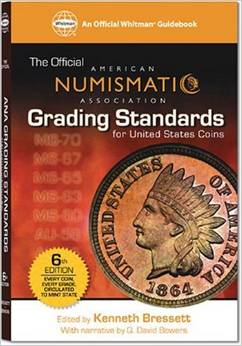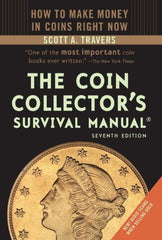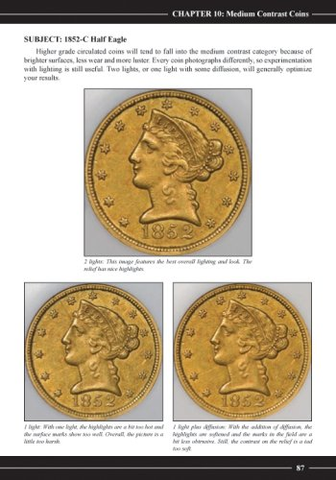The 5 Most Essential Books for Coin Collectors January 25 2015
"Buy the book before you buy the coin." That's one of the guiding principles of coin collecting, a lesson that many collectors unfortunately have to learn the hard way. In the field of numismatics, knowledge is power, and that power can make the difference between buying a valuable coin or a worthless counterfeit. Coin collecting is one of the oldest hobbies in the world, with thousands of numismatic books written over the centuries. And with the hobby's recent rapid expansion, thousands more have been written over the past couple decades. This list pares all those thousands down to the five most essential books for coin collectors. While the list is geared towards beginning collectors, numismatists of all levels should be able to find value in these books.
The Most Essential Coin Books Chart
| Picture | Title | Author | Published |
|---|---|---|---|
|
|
A Guide Book of United States Coins AKA "The Red Book" |
R.S. Yeoman and Kenneth Bressett |
First published 1947, annual revised editions since then |
 |
The Official American Numismatic Association Grading Standards for United States Coins |
Edited by Kenneth Bressett |
2005 (6th edition) |
 |
The Coin Collector's Survival Manual |
Scott Travers |
2015 (7th edition) |
 |
Numismatic Photography |
Mark Goodman |
2009 (2nd edition) |
 |
The Expert's Guide to Collecting & Investing in Rare Coins | Q. David Bowers | 2006 |
A Guide Book of United States Coins ("The Red Book")

Easily the best-selling numismatic book of all time, The Red Book (known for its iconic red cover) has been published in annual editions since 1947. While it was originally published as a simple price guide for U.S. coins, The Red Book has evolved and expanded over time to include additional information about each series of U.S. coins, as well as tons of supplemental information about numismatics in general. The Red Book's prices are based on the retail prices of hundreds of dealers, which means they aren't a great measure of how much you can sell your coins for. For that, you would be better served looking at sold listings on eBay. But The Red Book's coin prices will provide a good idea of relative value and scarcity for beginning collectors, so that you can start to understand the keydates, semi-keys, and common coins within each series. And the supplemental information The Red Book contains is valuable for any collector just getting into the hobby.
The Official A.N.A. Grading Standards for United States Coins

Any price guide is useless if you don't know how to determine the condition, or grade, of a coin. This book presents the grading standards of the American Numismatic Association, standards that are used throughout the coin market. The book helpfully breaks down the main grades for each U.S. coin series into obverse and reverse pictures, along with line by line descriptions of the level of wear and luster for each grade. Each design of coin wears differently, so it's important to understand the particular areas to look at when judging grade on any given coin (particularly when judging About Uncirculated vs. Mint State).
The Coin Collector's Survival Manual

Once you've mastered the basics of pricing and grading, this book should be your next stop. Filled with vital information on how to navigate the sometimes treacherous waters of coin collecting, this book touches on many subjects. Included are chapters on how to avoid scams, how to detect counterfeits, how to safely and intelligently buy coins online, how to secure and protect your collection, and many other need-to-know topics for the beginning collector. Reading through this book will give you a definite edge up on the rest of the new collectors who wade into numismatics without sufficient knowledge of how the industry works. Some of the information in this book has become a little bit dated over the years (despite the new editions), but the bulk of it is still enormously valuable.
Numismatic Photography

This book may seem somewhat of an odd choice for the list, as not everybody has the need or desire to photograph their coins. But I would hazard a guess that the vast majority of collectors have bought, or considered buying, a coin online. What are you basing that purchase decision on? A couple of pictures, and maybe a line or two of text description if you're lucky. Having a working knowledge of the techniques of numismatic photography then becomes vital, as it can help buyers deduce how a coin actually appears in hand - no matter the quality of the online pictures. For the online coin buyer, this book will reveal the tricks of the trade and enhance your judgment of online coin listings. For the coin seller, this book is the source of information on coin photography techniques. Ever jealous of those eBay sellers with the studio-quality coin images? Odds are they've read this book. And ever wondered how to capture the rainbow toning on a slabbed Morgan, without getting that annoying slab glare? This book will make it easy.
The Expert's Guide to Collecting & Investing in Rare Coins

This book represents somewhat of a stepping stone between coin collecting basics and the more advanced strategies of collecting. I would advise beginning collectors to read the other books on this list before opening this one. Written by the preeminent numismatist Q. David Bowers, this book delves into the ins and outs of the rare coins investment market, while also providing a history of the market from the 19th century onwards and an overview of the most important things to know when buying each of the major types of U.S. coins. Measuring in at a hefty 650 pages, this book is somewhat weighed down by Bowers' typically verbose prose. I would not recommend reading it cover to cover, but would instead suggest picking out the most interesting and relevant chapters for yourself. I personally found his chapters on the history of the rare coin market quite interesting, and would also suggest reading through his chapters on online buying and auction bidding.







